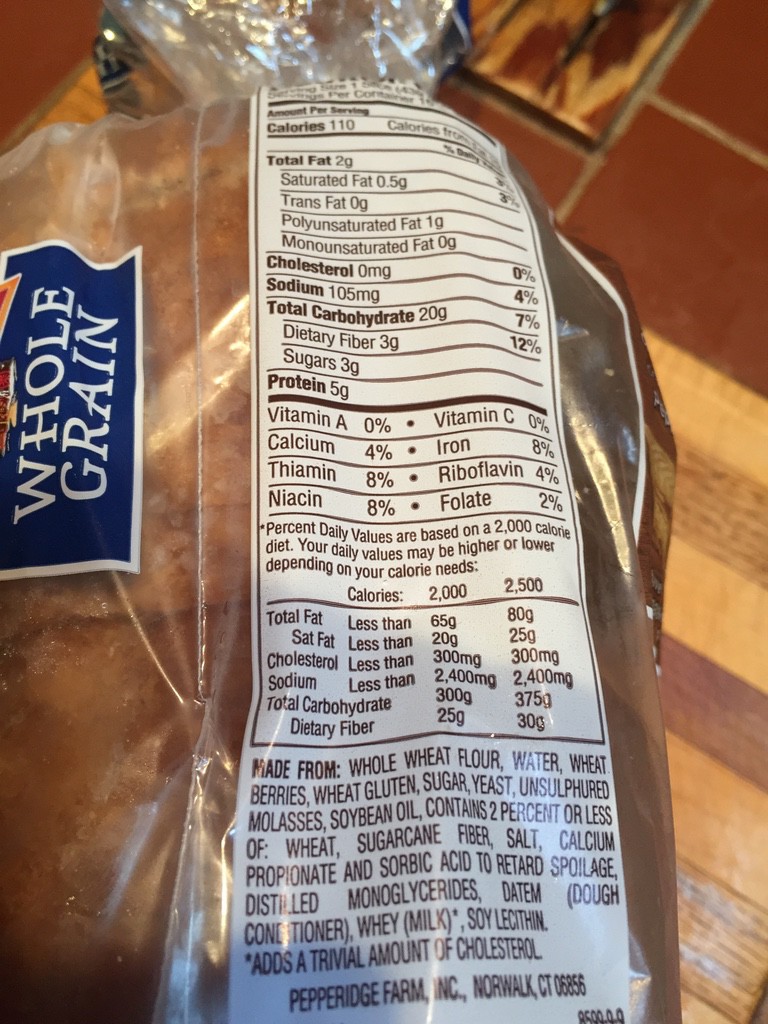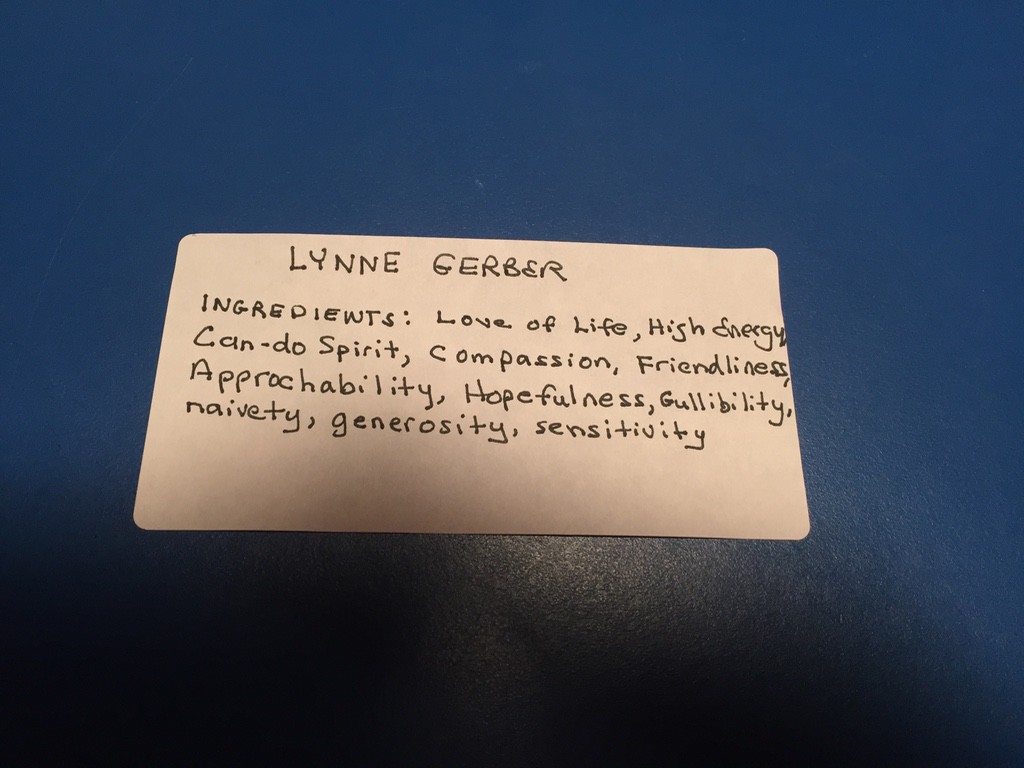5The “Check the Facts” lesson was principally about paying attention to nutrition labels.
I went into the week determined to scrutinize the labels on the “inner aisles” of the grocery store, where I had been warned some time ago to enter with care. The outer aisles are the healthy ones — or at least the areas of the store that you don’t have to worry so much about the “fine print,” because — except in the dairy portion, there isn’t much writing at all. The outer aisles hold the fruits and vegetables, the meats, eggs, milk, the yogurt, cottage cheese, and the like. The inner aisles sport the crackers, cookies, breads, beans, pastas, canned goods, etc etc. The inner aisles are awash with labels, which is a good thing —-if you know how to read them.
I found out, starting during class and then when shopping, that reading them is not enough; you have to compare them carefully. You need to look not only at the part about calories and serving sizes; you really need to look at fat content, and the make up of the carbohydrates content, as well as study the nutrients to be sure you get the protein and vitamins that you need. I also found out that it takes time to get the hang of it…and I definitely am not there yet.
For instance, I bought 100% Whole Grain bread…and felt proud of myself until I got it home and realized that instead of 60 calories a slice I knew someone in class had mentioned, it is 110 ( I did see that in the store, but it didn’t really register). And although it is delicious, it is not 50 calories worth more delicious than the whole grain bread I bought at the end of the week, after someone in class recommended it.
And I didn’t spend enough time comparing different yogurts and cottage cheeses…got things home that my health conscious sister-in-law tsked tsked as she moved her fingers down the labels and pointed out all the mistakes I had made compared to when she goes shopping.
Oh, well…we ARE talking life style change here…I can’t expect to be an expert over night. But the “science major” that I was way back in college is kind of enjoying this new sojourn that lets me become a combination of lab tech and mathematician. I’ll get better at it as I go along, I am sure.
Scrutinizing the labels on the packages did get me thinking about other labeling related to weight and health and how it would behoove everyone to pay more attention to THOSE other kinds of labels, that I have come to call this week “Put down labels.” And when I say “pay more attention” to them, I mean, catch ourselves using them and heed when others use them, and try to replace them with “healthier labels” that speak to the whole person, and not just their appearance or age.
Here are some examples of the “put down labels” that I have heard — and sometimes thought or said myself of myself.
Re being overweight:
“Fat”
“Flabby”
“Fat and Lazy”
“Fatty”
“Fat Slob” or “Big Fat Slob”
“Tub of Lard”
“Tubby” or “Chubby” (often as nick names)
“Pleasantly Plump” (pretending to be a compliment)
“Big Boned” (as an excuse or explanation)
“Rotund”
“Couch Potato”
“Out of Shape”
Re age:
“Old”
“Blue haired”
“Old and Gray”
“Old and Wrinkly”
“Old and Out of Shape”
“Over the Hill”
“Getting On In Years”
“Out to Pasture”
“Old Wildebeast”
“Little Old Lady”
“Used Up”
“Worn Out”
The thing that is the most damaging about those labels is that as we say them over and over – particularly about ourselves – they begin to be the “first liners” on the label that would describe what we are made of . They come first (up there where the calories and serving size would be on a “put on label” describing who were are), before the things that describe our character and attributes. And such labels become debilitating.
One of my Eat Smart, Move More, Weigh Less buddies was telling me during last week’s “power walk” about a trip she took lately to France, and when she was there, she saw on Facebook that someone she worked with about 15 years ago was in the same town and suggested they get together for lunch. She told me she almost did not go, because she had gotten “so fat” and she didn’t want him to see her that way. So convinced was she that he would judge her and think less of her because she had gained about 50 pounds since she had last seen him, that she almost missed a chance to catch up with each other and renew a friendship. Luckily, she “ripped off” her own label of inadequacy, said “yes” to getting together, and had a great time. And chances are, if he had designed a label for her to put on to describe herself, all her great qualities of personality and intelligence and attitude would have been way at the top, with much larger percentages than her weight and the one or two wrinkles and gray hairs that may be beginning to appear.
I took a stab at crafting the label I would want to “put on” that would describe myself. While the label might have my weight, height, and age, they are of little importance to my real self. What appears at the top are my main ingredients of “Love of Life,” “ High Energy” “Can-Do Spirit,” “Compassion,” “Friendliness,” “Approachability,” and “Hopefulness.”
What are the ingredients on YOUR label?
Here are my notes from Lesson 7: Enjoy More Fruits and Vegetables
Don’t simply ADD fruits and vegetables to your daily diet, substitute them for things that are higher in calories, low in fiber, and not as filling over time.
In planning your meals and snacks for the week, switch out things like potato chips, crackers, candy bars, and cakes and pies with apples, carrots, grapes, melon, celery, cherries, peaches, and pears.
Here are some strategies for adding fruit to your meals:
Keep fresh, frozen, and canned fruit on hand (but, be sure to read the label on canned fruit, to make sure it is packed in water or own juices, and not with sugared syrup.
Freeze some of the fresh fruits yourself – such as grapes, berries, and cherries.
Put fruits such as grapes and apples into your tuna or chicken salad, or simply in fresh salads.
Fill snack bags with fruit to take with you for work, or on a day trip.
Keep a bowl of fresh fruit in your kitchen, and if you put them in the fridge, put them at eye level.
Likewise, for vegetables:
Keep plenty of fresh, frozen, and canned vegetables on hand ( And, again, check the label on canned vegetables before buying)
Go to farmer’s market this time of year, and stock up on squash, eggplant apples, for roasting, baking, stewing, and freezing.
Eat lots of salads, as main dish for lunch or dinner, or at least as a side dish.
Buy frozen vegetables in bags, so that you can use what you need and put remainder back in the freezer for a later time.
Prepare snack bags of vegetables (eg. baby carrots, broccoli and cauliflower florets) to take to work or on day trips.
Grill and roast vegetables.
My strategies for the week:
Freeze some fruit in snack bags for snacks.
Enjoy the “rainbow of produce” that this season can bring to our plates.
At the end of our lesson, Rachel took us to this Zumba video; it was great fun!
